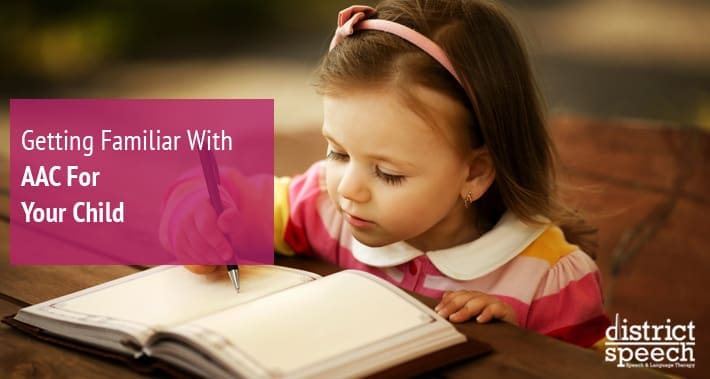
Communication is an important skill for interacting with the world and making sure your needs are met.
People accomplish those goals in a variety of ways and what works best will vary between individuals.
It can be frustrating, stressful, or even frightening when someone you love has speech or language difficulties.
However, it’s important to remember that spoken language is far from the only way to communicate.
If your child is struggling to develop or maintain language skills, District Speech can help out with speech therapy for kids.
In this article we’re going to talk about augmentative and alternative communication strategies and how they can be used to help your child.
What Is Augmentative/Alternative Communication (AAC)?
Augmentative or alternative communication (AAC) can be used to describe a myriad of different non spoken communication methods.
Most people use AAC casually all the time when they pass notes or use body language and hand gestures.
AAC is often used to describe a systemized approach that allows an individual with a speech or language problem to communicate.
Some people use AAC for most of their communication, while others use it for support in specific circumstances.
However, it’s important to remember that almost everyone uses AAC to some degree.
AAC can be especially beneficial to your child if they experience communication difficulties.
This may be from a developmental disorder like autism spectrum disorder, a speech disorder like selective mutism, or a motor disorder like cerebral palsy.
What Types Of AAC Are There?
Whatever your child’s needs are, there are AAC options available for them.
There are many different types of AAC.
Generally, though, AAC is divided into two main categories.
These categories are based on whether or not a device is used to aid communication.
Let’s take a closer look.
1. Aided AAC
Aided AAC makes use of some kind of device to assist with communication.
There are a wide range of options available for aided AAC.
Aided AAC options are also subdivided into two main categories, low tech and high tech.
High tech AAC devices make use of a computer or tablet to help provide a “voice”.
If your child uses high tech AAC, they may type or pick out images on a screen.
When they do this, their AAC device generates speech.
A low tech AAC system is pretty much anything else that helps with communication.
This might look as simple as using a pen and paper to write things down.
Often, though, it’s more complex.
Your child might use a board with pictures on it that they can point to for communicating specific needs.
This could look like a picture of a toilet if they need to go to the bathroom or an image of a plate if they’re hungry.
Another similar option would be a set of cards with words or images that your child can carry around with them.
2. Unaided AAC
Unaided AAC can be used without anything but the speaker’s own body.
Like with aided systems, unaided AAC can vary quite widely in complexity.
Things as simple as facial expression, gestures, and body language qualify as unaided AAC.
Other things like a limited or complete sign language vocabulary also qualify.
Because it doesn’t require specific equipment, unaided AAC can sometimes be a more accessible option for families trying it for the first time.
The most well known method of unaided AAC is the use of sign language.
Does Your Child Need AAC?
AAC can be a useful way to communicate as either a short or long term solution for individuals with speech or language difficulties.
It’s a good idea to consider AAC for your child if they’re having difficulty communicating verbally.
AAC does not replace verbal ability, either.
In fact, it can actually help your child’s verbal speech improve.
However, some people will need it to replace verbal speech, like if your child is autistic and nonverbal, for example.
If you’re unsure about using AAC with your child, you can consider how frustrated they get when communicating.
You can also consider how frustrating it gets when you’re trying to understand their communication.
If communication is frustrating to your or your child, it might be time to consider using AAC.
Some other factors to consider include your child’s ability to:
- Access resources at home, at school, and in the community
- Interact with family members and peers
- Access the school curriculum and participate in classroom activities
- Communicate progress at school to their teachers
- Navigate day to day situations independently
If you’re unsure, book an appointment with District Speech.
We can assess your child’s individual needs and aid you in finding the right path for your child.
Remember, early intervention is important for your child.
In fact, it’s never too early to begin speech therapy, especially where AAC is considered.
The sooner your child can begin working with a speech therapist, the smaller their gap in social and communication skills will be from their peers.
RELATED: When Should I Take My Child TO An SLP?

How To Choose An AAC For Your Child
There are many options for AAC systems depending on your child’s specific needs, strengths, and weaknesses.
Things to consider when picking a type of AAC system include your child’s mobility, including their gross motor skills and fine motor skills.
It is also important to consider your child’s cognitive abilities.
There are also some external factors that can influence the type of AAC that works best for your child.
You might want to consider the type of use for your child.
Will they be using it at home to communicate their needs?
At school for education?
Time frame is another external factor you can consider.
Is the device intended to be used in the long term to aid or replace speech?
Or will it be used for the short term as your child’s speech continues to develop?
Finally, the availability of different devices can be part of your consideration.
Do you have the funds for a high tech device, or do you need to look at low tech options?
If your child has used AAC in the past, you may also want to consider that experience.
What worked well for them with the type of AAC they used then?
What challenges did they face with their AAC device?
If you’re unsure of what method to use, there’s rarely harm in trying something to see if it works.
Even if you think you know exactly what will work, there’s no real way to be sure until you try it.
You and your child will need to work together with their new AAC device to understand its strengths and limitations under different circumstances.
It’s always important to understand how to use your child’s AAC device yourself.
That way you can help guide their learning and support them when they need it.
Book Your Appointment With District Speech Today
Navigating alternative communication methods with your child can be difficult.
Fortunately, you don’t have to do it alone.
At District Speech and Language Therapy we want to support you and your child in finding strategies to communicate as easily and effectively as possible.
Book an appointment today to get your child started on their journey to better communication.
Book your appointment with District Speech today.
1300 I St NW, Suite 400 E,
Washington, DC 20005
- https://g.page/districtspeech
District Speech and Language Therapy specializes in speech therapy, physical therapy, and occupational therapy solutions, for both children and adults, in the Washington D.C and the Arlington Virginia areas.